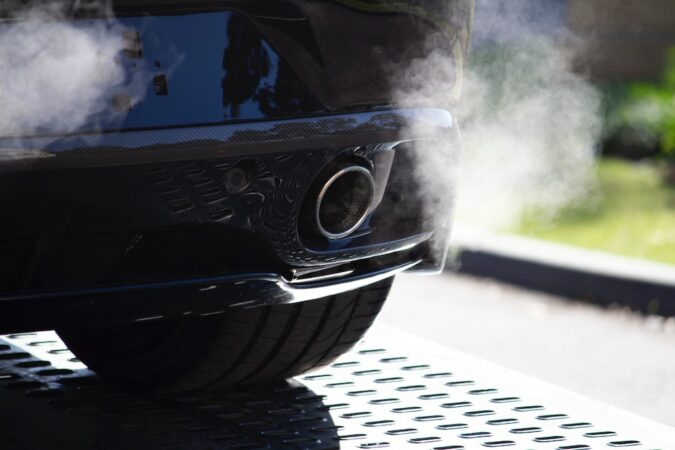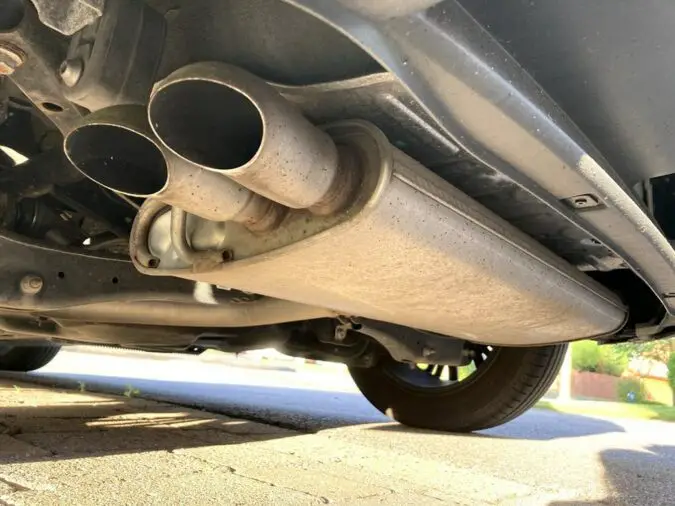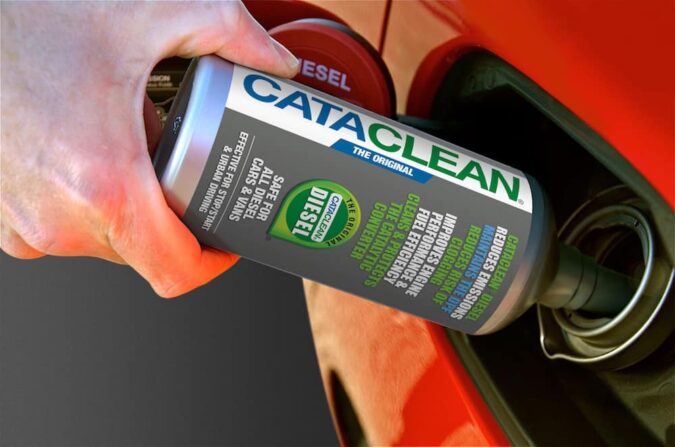Before they exit the car’s exhaust system, a catalytic converter changes the engine’s toxic exhaust gases into less dangerous ones. If you own a Prius then there’s a good chance efficiency is something you hold with importance. You may wonder about the Prius catalytic converter price.
The catalytic converter resembles a muffler in appearance. The standard housing comprises stainless steel and contains a ceramic honeycomb that is rich in platinum, palladium, and rhodium.
These components assist in cleaning up dangerous exhaust gases that would otherwise come out through the tailpipe.
- Prius Catalytic Converter
- Catalytic Converter Replacement
- Fix A Catalytic Converter
- Catalytic Converter Theft
- Install Catalytic Converter
- Frequently Asked Questions
Prius Catalytic Converter
Replacement catalytic converters for Toyota Prius models typically cost between $2,120 and $2,150 (just as costly as something like a 2012 Infiniti QX56 catalytic converter replacement or a Jeep Commander catalytic converter). That’s something you’ll eventually have to think about when wondering how long do Toyota Prius last.
Between $90 and $110 is the cost of labor that you can expect to pay, and between $2,030 and $2,040 is the cost of parts. At the very least, that’s not as expensive as a Prius battery replacement.
Taxes and other fees are not part of the above costs. The car might need more repairs.
Catalytic Converter Replacement
The majority of car owners won’t ever need to repair their catalytic converter while their vehicle is still on the road.
They are durable and do not experience the same levels of deterioration as the car’s moving elements.
But with time, rust accumulation and severe bumps to the underside of the automobile could harm your catalytic converter irreparably, necessitating complete replacement.
By replacing the catalytic converter yourself, you could significantly reduce your expenses (and once you’ve found a good catalytic converter replacement shop near me as well as where to find a catalytic converter near me for a 2012 Nissan Sentra catalytic converter replacement).
A Step-By-Step Guide
1) Ensure that you park the vehicle in a level spot and jack up all four wheels to lift the vehicle entirely off the ground.
2) Verify that the exhaust has had enough time to cool. After the car has been running, do not try to replace the catalytic converter.
3) Find the catalytic converter. The catalytic converter can be located (for more insight, check out our guide on the Ram 1500 catalytic converter location and how many catalytic converters are in a Dodge Avenger). Finding it shouldn’t be difficult; it will seem like a box in the center of the car’s exhaust pipe system.
4) Examine the converter to check if it is bolted or welded to the vehicle. You might not be able to remove it yourself if it has been welded into place.
You can carry out the replacement yourself if you have access to the right tools and feel secure removing the converter.
If not, you will need to bring your vehicle to a garage so that a mechanic may examine it.
5) Remove the primary catalytic converter’s oxygen sensor. More than one oxygen sensor may be included in some car models.
6) It may still be challenging to remove your converter even if it is bolted, as opposed to welded. The bolts may become rusted, which will make it very difficult to remove them. An option for you might be penetrating oil.
Each Catalytic Converter Is Different
7) Each catalytic converter differs somewhat, despite the fact that they all perform identical functions. This implies that the installation procedure may vary from converter to converter. If the new converter you bought comes with instructions, make sure you read them thoroughly and pay attention to them.
8) When a new catalytic converter is installed (which you could scour around to look into the catalytic converter price lookup as well as the price of a new cat converter and bearing in mind replacing catalytic converter in California), it frequently includes a little gasket that fits within the pipes that surround it and keeps it securely in place. Installing these first before inserting the converter itself is necessary if your converter includes them.
9) Your new catalytic converter (to learn more, check out our guide on replacing catalytic converter with flex pipe, as well as the Ford V10 motorhome catalytic converter and the Dodge RAM catalytic converter) should have an arrow pointing in the direction that it should be put. Additionally, when you set it in position, you must ensure that the right side is downward.
10) If you get an extra set of hands to assist you, the subsequent stage will be considerably simpler. The best course of action would be to find someone to hold the converter in place while you work on the bolts because holding the converter while doing repairs is not an easy task.
11) Start by tightening the nuts as much as you can with just your fingers. If you wait to fully tighten the bolts until all four are in place, it will be simpler to align them in all of the bolt holes.
Tighten The Bolts
12) Because loose bolts are the main cause of exhaust leaks, you should tighten the nuts as much as you can.
13) Adjust the oxygen sensors’ positions and firmly fix them. If the wiring is incorrect, double-verify it to avoid setting off dashboard alerts.
14) It is crucial to get your exhaust inspected when everything has been put back in place. To ensure that your car is secure for usage on the road, it must pass an emissions test.
Your car’s catalytic converter is a crucial component, and improper installation might have negative effects on both the environment and your car.
It is crucial that you immediately take your automobile to a garage to get it checked out by a professional if you have any concerns or reservations at any stage throughout the installation.
Catalytic Converter Replacement Cost
Is it expensive to replace a catalytic converter? And, how much does a catalytic converter cost?
The Prius catalytic converter price of replacement varies from model to model like any other auto repair (as one would with a Volvo catalytic converter).
The typical Prius catalytic converter price to replace a damaged catalytic converter is between $945 and $2475. Some specialty vehicles might be even higher. This is more or less equivalent to the Honda catalytic converter price for a replacement.
However, expensive catalytic converters are just the beginning. You must account for diagnostic charges and potential problems that result from the failure in addition to the repair itself. The costs will also vary depending on where you get a catalytic converter repair near me.
For instance, you could also need to replace the muffler, the tailpipe, or one or more oxygen sensors. A thorough Prius catalytic converter price analysis is what you should have before starting the repair. It might cost more to fix it than the automobile itself.
Prius Catalytic Converter Price – The Labor Costs
The Prius catalytic converter price of labor to replace a catalytic converter can range from $70 to $130 per hour. The converter system is outside and may be fastened to the vehicle’s engine with rusty studs or bolts.
It can take some time for the mechanic to solve any problems they encounter when replacing your catalytic converter.
Cheapest Way To Fix Catalytic Converter
It is definitely a good idea to properly analyze the car to see why it failed and whether it is defective before attempting to restore the catalytic converter.
There are several reasons why it can fail and why you could assume it failed, as we have already discussed. But if you are positive that it requires fixing, you can follow these steps. After all, there are some ways how to fix a catalytic converter without replacing it outright.
Prius Catalytic Converter Price, Diagnosis & Fixes – Step 1
Try performing a few freeway pulls if you don’t see any serious symptoms and only a minor rise in fuel consumption and a marginally detectable loss of power. It’s likely to not cause serious issues such as how your Toyota Prius won’t start.
Naturally, make sure you obey the speed limit and don’t put anyone else at risk on the road.
The catalytic converter will heat up and experience significantly higher flows (akin to a high flow catalytic converter) than typical if that is, you do some high-speed driving at high RPMs.
If you don’t get a speeding ticket, those two factors combined are often sufficient to overcome any barriers in the honeycomb (to learn more, check out our guide on what do catalytic converters do and what does a catalytic converter do), potentially saving you a ton of money.
Prius Catalytic Converter Price, Diagnosis & Fixes – Step 2
Your catalytic converter typically only needs cleaning if you just travel in cities, don’t drive recklessly, or do only brief, short journeys.
There are many gasoline additive catalytic converter cleaners available that you might use for that. CataClean, CRC “Guaranteed To Pass,” and Solder It “Cleaner & Deodorizer” are a few examples. If you need a DIY solution, you can even consider using lacquer thinner as a catalytic converter cleaner.
You’re ready to travel after simply pouring the entire container into your gas tank. If that doesn’t work, though, try the next option.
Prius Catalytic Converter Price, Diagnosis & Fixes – Step 3
Flush the cat. The best way to flush a catalytic converter is to remove it, which can sound like a headache. By shining a light through the converter, you may determine whether it has been properly cleaned (with a catalytic converter cleaner, for example) as well as whether it is clogged.
Every car has a distinct removal procedure, and in some circumstances, it might not even be possible. However, if you squeeze under the car and look to see whether it’s bolted on, which it typically is, you can quickly determine if you can do it.
Then, all that’s left to do is remove it with a few wrenches and some rust remover. Just make sure you re-install the cats back, as removing a catalytic converter outright will fall foul of the law.
Once you’ve done that, immerse it in some soapy detergent water for the night, and the next day, flush it with a garden hose. If it isn’t clean, repeat the process after checking.
Instead of detergent, you can also use sodium hydroxide, but be sure to work outside and wear a mask the entire time.
Prius Catalytic Converter Price, Diagnosis & Fixes – Step 4
If changing your catalytic converter is the only option, look for a used one that fits your car’s make and model.
Undoubtedly, it won’t be simply because most of them are cut out and sold for scrap, and they won’t be that inexpensive either.
As an alternative, a fresh universal catalytic converter might suffice. The placement of your stock converter will determine whether or not you can install one.
It’s likely that it won’t be possible or that it will take a lot more labor if it’s on or close to the exhaust manifold.
However, depending on the size and your luck, you might be able to purchase a brand-new universal converter for between $70 and $250.
Prius Catalytic Converter Price, Diagnosis & Fixes – Step 5
Numerous things can point to a faulty converter even if there is no clogging or melting (be wary of the clogged catalytic converter symptoms). Check for exhaust leaks on all parts, including the catalytic converter, before you replace it.
Check to see that the O2 sensor is sealing correctly and that its threads are not faulty.
At the very least some, and frequently, you can resolve all the signs of a bad catalytic converter (as well as knowing the catalytic converter life expectancy and how to diagnose a code P0420) by repairing an exhaust leak, which is also very affordable.
You can repair a tiny exhaust leak for as little as $30, but a severe one can cost up to $100.
Prius Catalytic Converter Theft
Vehicles of all makes and models have been the victims of catalytic converter thefts (what you need then, is the best catalytic converter anti-theft device or a catalytic converter cover and an F-150 catalytic converter protector, and knowing the signs of missing catalytic converter), which have been occurring all throughout the country.
The Toyota Prius is a target by thieves, according to the L.A. Times, particularly in the western states that are coastal havens for hybrid and electric vehicles, including California and Oregon.
Furthermore, it’s not just any Prius or even brand-new. The second and third-generation Prius models from 2004 to 2009 include converters that thieves covet. So, that’s something to consider when thinking about buying a used Prius (especially once you understand why do catalytic converters get stolen and how to stop catalytic converter theft).
Also keep in mind that at the time, the Prius was hotter than the current heat wave. Everyone wanted a second-generation Prius, from common people to celebrities who wanted to be eco-friendly because it was the thing. For months, many waited to get their hands on them.
As a result, there are still millions of vehicles on the road for thieves to pick from thanks to the sales of the two generations and Toyota’s dependability. In that case, you may want to put these in the list of Toyota Prius years to avoid.
A Rise In Catalytic Converter Thefts
According to data, there has been an increase in catalytic converter thefts nationwide. Ford F-150s (for more insight, check out our guide on the F-150 catalytic converter anti-theft and how to know if catalytic converter is stolen) and Honda Accords are the primary targets in other regions of the nation.
However, the information offered by Carfax reveals an intriguing finding. It all boils down to what vehicles have the most valuable catalytic converters.
The Toyota Prius is the most popular target for these thefts in the west. You may be curious as to why a random hybrid model might be a target for theft (to find out more, check out our guide on how to know if your catalytic converter is stolen). It’s all about making money, not because they’re thinking about are Prius good cars.
In catalytic converters fitted to hybrid vehicles, the precious metals are present in larger proportions (fun fact, check out our guide on the catalytic converter precious metal prices). According to The Times, a Prius converter can bring more than $1,000, compared to $150 for an F-150 converter. This is among the factors why catalytic converters are so valuable.
Theft claims are severely impacting insurance businesses from Hawaii to New Mexico (including the catalytic converter theft in Texas and considering techniques concerning catalytic converter theft prevention and the most common catalytic converters stolen). The Highway Loss Data Institute’s data reveals that from 2019 to 2021, thefts increased by about 850 percent.
Sadly, nothing seems to be preventing the robberies even when police agencies advise security precautions including parking in well-lit areas and using locked garages. Otherwise, it might also help to have a DIY catalytic converter protection.
Prius Catalytic Converter Shield
A catalytic converter shield (such as the Prius catalytic converter protection device and figuring out how to protect your catalytic converter) is a covering for a catalytic converter that serves as a barrier against the heat it releases to safeguard adjacent parts. We will see why it is a great component to install in your Prius.
What if you could cover your Prius Catalytic converter with a piece of material to shield it from the elements or keep it safe from thieves? In this instance, the catalytic converter shield or cover guards against the weather, debris, excessive heat, or theft.
Although there are many materials that can be utilized to make a catalytic converter heat shield, stainless steel is the most popular choice. Others have flexible aluminized polyester film finishes on woven glass. Some have a flexible mylar coating on woven silica material.
What Does The Prius Catalytic Converter Shield Do
Let’s take a look at some of the main functions of a catalytic converter shield and see why you may want one for your Toyota Prius.
1. Prevents Theft
Perhaps the most important function of the cat shield as far as the Toyota Prius goes is that it would do a great job of preventing thieves from accessing the catalytic converter.
A thief may be discouraged from attempting to steal a converter if they notice that it is shielded or concealed because doing so will take longer, create more noise, or possibly result in them being discovered. For more thoughts, check out our guide on why steal a catalytic converter.
2. Lowers Internal Temperatures
This prevents gearboxes from overheating and reduces wear and tear on the converter and related components. Additionally, it stops neighboring rubber or plastic car parts from melting due to radiant heat from the converter.
If the converter heats up excessively, it could harm other car parts or even catch fire.
3. Eliminates Converter Clogs
It can stop extraneous things from harming the catalyst by entering the converter (to learn more, check out our guide on what’s a catalytic converter). This is crucial since if an unwanted object gets inside the converter, it could block the catalyst and lower its efficiency. If so, you’ll then have to learn how to unblock a catalytic converter.
4. Maintains The Converter’s Cleanliness And Lowers Emissions
By catching pollutants before they can enter the converter, the cover lowers emissions. Additionally, by keeping debris from getting inside, it maintains the converter clean.
Additionally, it prevents outside impurities and moisture from getting inside the converter. The effectiveness of the converter may be harmed if moisture or other contaminants got inside.
Install Catalytic Converter
Installing a catalytic converter that is bolt-on style in the exhaust system.
You can install a catalytic converter in a variety of ways; the specifics depend on the vehicle. In this instance, we’ll discuss the more typical bolt-on style, in which the catalytic converter you’ll install on the vehicle’s undercarriage.
Tools Required:
- Wrenches
- Jack
- Jack stands
- Penetrating oil
- A variety of ratchets and sockets
- Extensions and joints for ratchets
- security lights
Step 1: Raise The Car And Stabilize It With Jack Stands
Make sure you raise the car high enough to allow for movement below it.
To stop the car from rolling, engage the parking brake and place stoppers or wooden blocks beneath the wheels.
Step 2: Locate The Catalytic Converter
Find the vehicle’s catalytic converter on the underside of the car.
Mainly, you can find it near the front of the car, normally on the rear side of the exhaust manifold.
In cases where a vehicle has more than one catalytic converter, it’s critical to identify which bank needs to get a new catalytic converter (as you would with a 2013 Audi A4 catalytic converter or a Honda Pilot catalytic converter, and make sure you know where to find catalytic converters for sale).
Step 3: Remove Any Oxygen Sensors
Remove any oxygen sensors that may be installed inside or close to the catalytic converter if necessary.
If the catalytic converter doesn’t have an oxygen sensor installed or needs to be removed, move on to step 4.
Step 4: Spray Penetrating Oil
Spray penetrating oil on the hardware and flanges of the exhaust flange and give them some time to soak. But, where is the catalytic converter?
Exhaust nuts and bolts are particularly vulnerable to rust and seizing due to their location on the underside of the vehicle and exposure to the environment.
Spraying them with penetrating oil can make them more easily removable and help prevent issues with stripped nuts or bolts.
Step 5: Get Your Tools Ready
To take out the catalytic converter, bolts, or flange nuts, determine what size sockets or wrenches you’ll need.
Sometimes removal calls for a number of extensions or flex joints, as well as a ratchet and socket on one side and a wrench on the other.
Before attempting to twist the hardware loose, take care to make sure the tools seat firmly.
Remember that the exhaust hardware is particularly susceptible to rust, thus you need to take great care to avoid rounding off or stripping any hardware.
The catalytic converter should be free to be removed once the hardware is removed.
Step 6: Replace The Catalytic Converter
To stop exhaust leaks, swap out the catalytic converter for a new one and replace any worn-out exhaust flange gaskets.
Make that the replacement catalytic converter meets the necessary requirements for the vehicle’s emissions standards as well. And, be wary of how much for catalytic converter.
State-by-state emissions rules differ, and if you install the wrong catalytic converter, the vehicle may not pass inspection.
Step 7: Installing The Catalytic Converter
Install a catalytic converter by following steps 1 through 5 in reverse order of removal.
Method two of two involves installing a catalytic converter integrated into the exhaust manifold.
Some automobiles have catalytic converters that fix into the exhaust manifold, bolted to the head or heads, and extend all the way to the exhaust system.
These catalytic converters are also fairly common, and in many cases, you can replace them with just a few simple hand tools.
FAQs On Prius Catalytic Converter Price
How Much Is A Catalytic Converter Worth
A catalytic converter’s average scrap value ranges from $300 to $1,500. Because it is made of precious metals, this component is one of the most expensive ones in a car.
How Much To Replace Catalytic Converter
It costs money to replace a catalytic converter. Prius catalytic converter price and cost of repairs will typically be between $945 and $2475 for most automobiles, components, and labor included. A catalytic converter can cost up to $2250 on its own. That could be more or comparable to the worth of your car.
Why Are Catalytic Converters So Expensive
Rhodium is required by your catalytic converter in order to lower pollution levels, hence it is pricey. Rhodium is now quite expensive, making it pricey to use in a catalytic converter. Manufacturers must raise the cost of the catalytic converter to cover their expenses.





